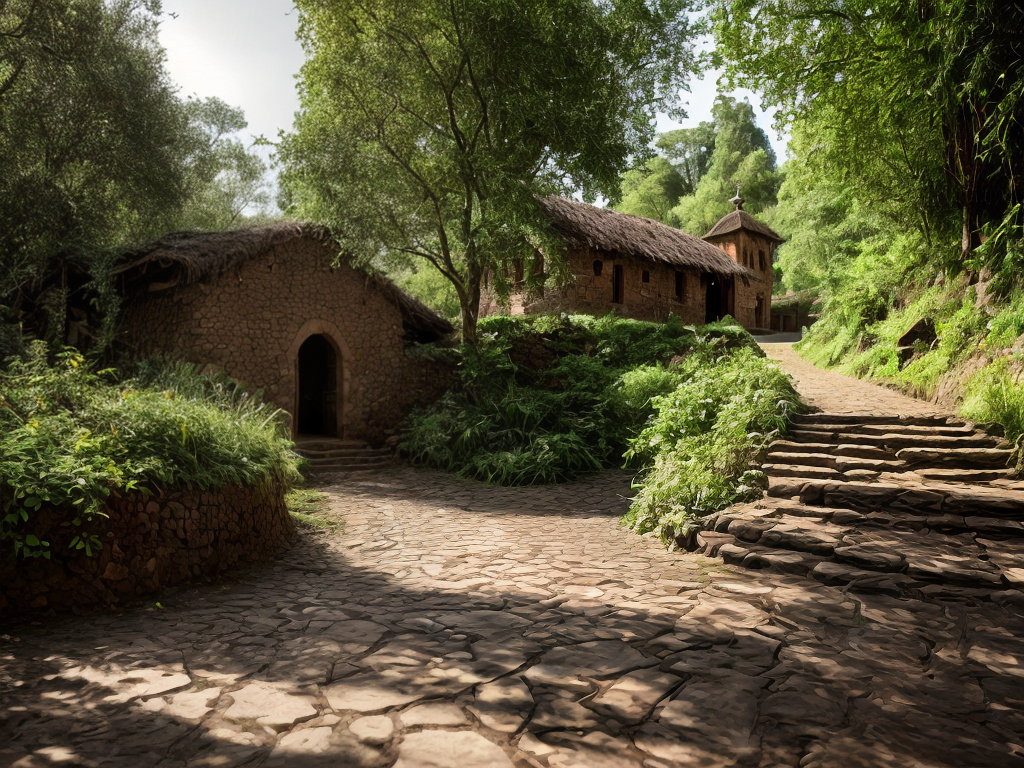As a passionate traveler, I’ve had the privilege of exploring countless historical sites. But none have captured my imagination quite like Lalibela’s landmarks. From the early origins to the rise of rock-hewn churches, these architectural marvels tell a captivating story of human ingenuity and religious devotion. Join me as we embark on a journey of discovery, tracing the evolution of Lalibela’s landmarks and uncovering the rich history that lies within their ancient walls.
Early Origins of Lalibela’s Landmarks
In my research, I discovered that the early origins of Lalibela’s landmarks can be traced back to the 12th century. Lalibela, located in present-day Ethiopia, was an important center of early settlement and held great significance in the region. The ancient traditions of the area played a crucial role in shaping the architectural marvels that we see today. The early settlers of Lalibela were deeply religious and sought to create a sacred space that would rival Jerusalem. Inspired by their devotion, they carved magnificent churches out of solid rock, creating a unique blend of architectural ingenuity and spiritual devotion. These landmarks not only served as places of worship but also as a testament to the rich cultural heritage and the enduring legacy of Lalibela’s early settlers.
Pre-Christian Influences on Lalibela’s Architecture
As I explore the pre-Christian influences on Lalibela’s architecture, it becomes evident that early architectural influences played a significant role in shaping the unique landmarks we see today. The fusion of different cultural and religious elements is evident in the structures, showcasing the rich history and diversity of the region. Additionally, these ancient structures are imbued with symbolism, reflecting the beliefs and values of the people who built them.
Early Architectural Influences
Often, I find myself amazed by the rich architectural influences that shaped Lalibela’s landmarks before the advent of Christianity. The early architectural styles found in Lalibela were influenced by the historical context of the region. One prominent influence on Lalibela’s architecture was the Axumite Empire, which ruled over Ethiopia from the 1st to the 8th century AD. The Axumite architecture featured large stone structures, such as obelisks and palaces, which inspired the construction of Lalibela’s rock-hewn churches. Additionally, Lalibela’s architectural styles were also influenced by the ancient Aksumite and Aksumite-Ethiopian architectural traditions, which incorporated elements such as carved stone facades and underground structures. These early architectural influences laid the foundation for the unique and awe-inspiring landmarks that Lalibela is known for today.
Cultural and Religious Fusion
While exploring the architectural influences on Lalibela’s landmarks, it is fascinating to delve into the cultural and religious fusion that shaped its architecture prior to the advent of Christianity. The rich history of Lalibela reveals a deep cultural assimilation and historical significance in its architectural development.
-
Influences from Ancient Ethiopian Kingdoms: Lalibela’s architecture reflects the fusion of pre-Christian traditions from ancient Ethiopian kingdoms such as Aksum and Axumite. The use of monolithic construction techniques and intricate carvings showcase the influence of these early civilizations.
-
Incorporation of Judaic Elements: Lalibela’s architecture also exhibits the assimilation of Judaic elements. The layout of the rock-hewn churches, resembling the layout of the Temple of Solomon in Jerusalem, highlights the influence of Judaic traditions.
-
Syncretism of Pagan Beliefs: The architecture in Lalibela also shows the syncretism of pagan beliefs with Christianity. The incorporation of natural elements, sacred springs, and ancestral worship sites demonstrates the blending of indigenous religious practices with the new Christian faith.
This cultural and religious fusion has left a lasting impact, making Lalibela’s landmarks not only architecturally remarkable but also historically significant.
Symbolism in Ancient Structures
Continuing from the previous subtopic, I discovered fascinating symbolism in the ancient structures of Lalibela’s architecture, revealing the influences that existed before the arrival of Christianity. These symbols provide a glimpse into the rich history and cultural heritage of the region. The intricate carvings and motifs found in the rock-hewn churches of Lalibela depict not only religious themes but also historical influences. Some of the symbols represent ancient Ethiopian deities, while others reflect the cosmological beliefs of the time. For example, the cross-shaped windows and doors symbolize the connection between heaven and earth, emphasizing the spiritual significance of these structures. Additionally, the use of geometric patterns and animal motifs showcases the integration of pre-Christian traditions with the emerging Christian faith. By studying the symbolism in Lalibela’s ancient structures, we can gain a deeper understanding of the historical and cultural context in which these landmarks were created.
The Rise of Rock-Hewn Churches in Lalibela
One of Lalibela’s most iconic landmarks is the rise of its rock-hewn churches. These magnificent structures, carved out of solid rock, are not only a testament to the incredible architectural skills of the ancient Ethiopians but also a major draw for tourists from around the world. The rise of tourism in Lalibela, driven largely by the popularity of these rock-hewn churches, has had a significant impact on the local economy. The influx of visitors has brought new opportunities for employment, with locals now working as tour guides, hotel staff, and artisans selling handicrafts. Additionally, the revenue generated from tourism has helped to fund infrastructure development and improve the overall quality of life for the people of Lalibela.
Unique Architectural Features of Lalibela’s Landmarks
As I delve into the unique architectural features of Lalibela’s landmarks, I am struck by the intricate carvings and elaborate detailing that adorn these ancient rock-hewn churches. The unique architectural designs of Lalibela’s landmarks reflect the historical significance of the region and its rich cultural heritage. These churches, carved out of solid rock, showcase a remarkable blend of Ethiopian and Byzantine architectural styles. The interior of the churches is equally impressive, with vaulted ceilings, ornate pillars, and beautifully carved crosses and religious symbols. The exteriors feature facades adorned with decorative elements such as geometric patterns, floral motifs, and biblical scenes. The attention to detail and the skillful craftsmanship of these structures highlight the extraordinary talent of the architects and artisans who created them. The table below provides a visual representation of the stunning architectural features found in Lalibela’s landmarks:
| Unique Architectural Features | Description |
|---|---|
| Intricate carvings | Elaborate detailing on the rock-hewn walls |
| Ornate pillars | Beautifully carved columns and supports |
| Vaulted ceilings | Arched ceilings with decorative patterns |
| Geometric patterns | Intricate designs inspired by mathematics |
These unique architectural designs not only showcase the artistic prowess of the builders but also serve as a testament to the historical significance of Lalibela’s landmarks.
Religious Significance of Lalibela’s Landmarks
What makes the landmarks of Lalibela particularly significant from a religious perspective? The religious practices and spiritual heritage associated with Lalibela’s landmarks contribute to their profound religious significance. Here are three reasons why:
- Sacred Pilgrimage: Lalibela is a site of pilgrimage for Ethiopian Christians, who believe that visiting the rock-hewn churches brings them closer to God. The devout undertake long journeys to reach Lalibela, seeking spiritual enlightenment and blessings.
- Divine Connection: Lalibela’s landmarks are considered to be holy places where believers can connect with the divine. The intricate carvings, murals, and religious artifacts within the churches serve as a visual representation of their faith and inspire a sense of awe and reverence.
- Cultural Identity: Lalibela’s landmarks are not only religious sites but also symbols of Ethiopia’s cultural and national identity. The spiritual significance of these landmarks is deeply intertwined with the country’s history, traditions, and people’s way of life.
Preservation Efforts for Lalibela’s Landmarks
I have actively participated in the preservation efforts for Lalibela’s landmarks, focusing on the restoration and conservation of these historical and sacred sites. To ensure the longevity of these remarkable structures, a variety of preservation strategies have been implemented. One such strategy involves the use of advanced technologies, such as laser scanning and 3D modeling, to document and analyze the current condition of the landmarks. This allows for targeted conservation efforts and helps in creating accurate replicas if needed. Additionally, community involvement has played a crucial role in the preservation process. Local residents and religious leaders have been actively engaged in the decision-making process, providing valuable insights and knowledge about the landmarks’ cultural significance. Furthermore, community-led initiatives have been established to raise awareness and funds for ongoing maintenance and restoration projects. Through these preservation strategies and community involvement, we aim to safeguard the rich heritage of Lalibela’s landmarks for future generations to appreciate and cherish.







